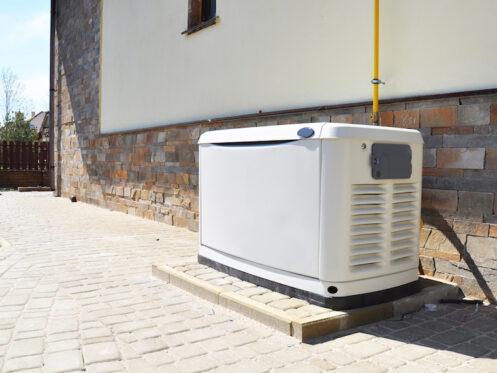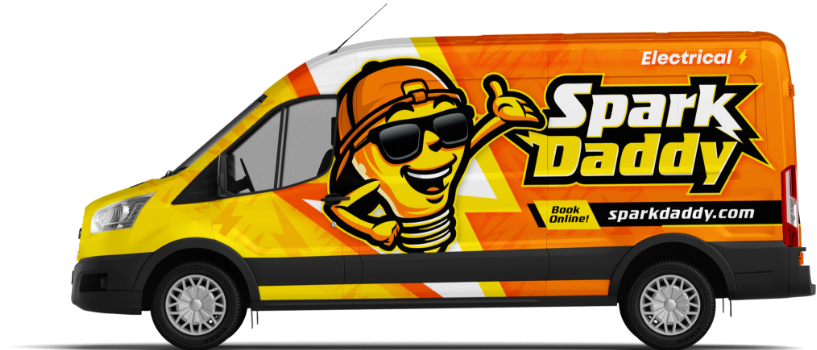The US Department of Energy suggests power outages cost American households billions annually. These costs are associated with replacing spoiled food, burst or frozen pipes, flooded basements, and renting a hotel room during the blackout. The best way to protect yourself from these expenses is a whole-house generator.
Whole-House Versus Portable Generators
When choosing a generator for your home, it’s crucial to understand the differences between whole-house and portable generators. While smaller-scale solutions like portable generators are generally less expensive upfront, a standby generator is often a better long-term investment.
Standby generators offer significantly greater power capacities and are integrated into your home’s electrical system. This integration ensures a seamless transition during power outages, automatically kicking in to provide uninterrupted power. In contrast, portable generators require manual setup and can only power a limited number of appliances simultaneously.
Additionally, the long-term costs associated with standby generators, including equipment and fuel, tend to be lower. Standby generators typically run on natural gas or propane, which are more cost-effective and reliable fuel sources than gasoline, commonly used for portable generators.
Portable generators are also less reliable for prolonged use, require frequent refueling, and can pose safety hazards such as carbon monoxide poisoning if not used properly. While portable generators seem like an economical choice initially, a standby generator’s safety, reliability, and convenience make it a superior option for ensuring your home remains powered during an outage.
Legal Requirements
Most local municipalities require a permit for the installation of a whole-house generator. This process is something that a professional electrician can handle for you as part of the installation. There will also be an inspection by a city official, which your electrician will deal with as well. Each jurisdiction has different rules. There are often noise limitations. Some jurisdictions limit where you can install a generator. These rules will inform your choices, so knowing them in advance is essential.
Electrical Panel Requirements
It’s also a good idea to schedule an inspection of your electrical panel early on. If you live in an older home, you may need an electrical panel upgrade. You may also have to bring your electrical system up to code in other ways. Even if you live in a newer home, you may need an electrician to install a dedicated circuit for the generator. A transfer switch is something that you’ll want to think about upfront as well. This component monitors your electrical system and enables the generator when it detects a power outage. It also prevents the electricity generated from leaking into the power grid to ensure the safety of utility employees working to restore power.
Fuel Source
There are three main fuel sources for standby generators: natural gas, liquid propane, and diesel. Most manufacturers offer their models in all three configurations. Natural gas is by far the most popular. The generator draws its fuel from a natural gas line, so there’s never any risk of running out. If your home is not connected to a municipal gas line, you can opt for propane instead. You would store the propane on your property in a tank and need to schedule regular deliveries. A diesel generator has the same requirements. However, not all jurisdictions allow diesel generators for residential applications.
Power Requirements and Priorities
The industry organizes residential standby generators into three categories:
- Essential circuit coverage
- Managed whole-house coverage
- Comprehensive whole-house coverage
Generators that provide essential circuit coverage are smaller units. They provide enough power for the basics: refrigerators, heating, cooling, and lighting. In addition, they will provide enough electricity for your sump pump to prevent a flooded basement. This is the most affordable option and is recommended if your budget is tight. Generators that provide managed whole-house coverage are mid-sized and allow for selective use of light and medium appliances. Units that provide comprehensive whole-house coverage are large and let you go about your day without thinking about your power usage during a blackout.
In all three cases, you’ll need an electrician to help you estimate your power consumption. Large systems should deliver your peak daily demand. With the smaller and medium units, you’ll need to decide what you’ll use and what you won’t. Based on this information, your electrician can then give you an estimate for installation costs.
Air-Cooled vs. Liquid-Cooled
The engine in a generator requires cooling. Air-cooled solutions are more affordable. They’re also more common among smaller generators. As you move up in size, liquid-cooled solutions become more prevalent. Liquid-cooled generators have longer lifespans. That makes the added cost worth it when making a large investment. The other consideration is ambient temperatures. If you live in a warm climate, it may be worthwhile to get air-cooled even if you opt for a smaller unit.
Enclosure
Manufacturers make generator enclosures from a range of materials. How much weather protection an enclosure provides is important. It must withstand sunlight, wind, rain, snow, and ice for many years. If you live in an area with high salt content in the air, then rust protection is important as well. There are also enclosures that insulate better against noise. Noise-dampening upgrades may allow you a more powerful generator while also meeting local ordinances.
Smart Features
Like many modern devices for the home, many generators have onboard computers that provide smart home features. These generators can, for instance, send a notification to your phone that power has gone out and auxiliary power is active. They can send alerts for low fuel. Many brands also have apps that let you monitor and control the generator through your phone or other device.
Warranty
Scrutinize the warranties included with the models you’re considering. Coverage varies not only across brands but often across the models those brands offer. Most manufacturers provide limited coverage for at least three years. They also allow you to extend coverage up to 10 years for both parts and labor. Note that most brands require you to activate the coverage by registering the unit. In the event of generator failure, you may also have to prove that a professional has maintained your unit annually.
Maintenance Requirements
All standby generators require routine maintenance. Ensure you know the manufacturer’s recommendations and what is required for warranty coverage. There are many similarities between the engines used in generators and automobiles. There’s a battery system to start the generator. There are fluids to check and replace or top off. Spark plugs and air filters are other components that your electrician will need to check and replace as needed.
Would You Like to Install a Whole-House Generator in Greater St. Louis?
Spark Daddy is a full-service residential electrical contractor with a team that’s served Ballwin, Pacific, and the surrounding areas for years. We perform whole-home generator installations and offer maintenance services to maximize your investment. Additionally, our licensed electricians provide a full range of other services. Count on us for inspections, repairs and installations, electrical panel upgrades, surge protection, indoor and outdoor lighting, EV charging stations, and more. Contact us today to schedule an appointment with one of our experienced team members.




